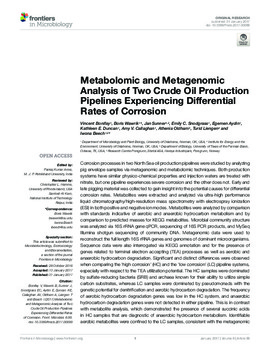| dc.creator | Bonifay, Vincent | |
| dc.creator | Wawrik, Boris | |
| dc.creator | Sunner, Jan | |
| dc.creator | Snodgrass, Emily C. | |
| dc.creator | Aydin, Egemen | |
| dc.creator | Duncan, Kathleen E. | |
| dc.creator | Callaghan, Amy V. | |
| dc.creator | Oldham, Athenia | |
| dc.creator | Liengen, Turid | |
| dc.creator | Beech, Iwona | |
| dc.date.accessioned | 2017-02-06T21:53:28Z | |
| dc.date.available | 2017-02-06T21:53:28Z | |
| dc.date.issued | 2017-01-31 | |
| dc.identifier.uri | https://hdl.handle.net/11244/48166 | |
| dc.description.abstract | Corrosion processes in two North Sea oil production pipelines were studied by analyzing pig envelope samples via metagenomic and metabolomic techniques. Both production systems have similar physico-chemical properties and injection waters are treated with nitrate, but one pipeline experiences severe corrosion and the other does not. Early and late pigging material was collected to gain insight into the potential causes for differential corrosion rates. Metabolites were extracted and analyzed via ultra-high performance liquid chromatography/high-resolution mass spectrometry with electrospray ionization (ESI) in both positive and negative ion modes. Metabolites were analyzed by comparison with standards indicative of aerobic and anaerobic hydrocarbon metabolism and by comparison to predicted masses for KEGG metabolites. Microbial community structure was analyzed via 16S rRNA gene qPCR, sequencing of 16S PCR products, and MySeq Illumina shotgun sequencing of community DNA. Metagenomic data were used to reconstruct the full length 16S rRNA genes and genomes of dominant microorganisms. Sequence data were also interrogated via KEGG annotation and for the presence of genes related to terminal electron accepting (TEA) processes as well as aerobic and anaerobic hydrocarbon degradation. Significant and distinct differences were observed when comparing the ‘high corrosion’ (HC) and the ‘low corrosion’ (LC) pipeline systems, especially with respect to the TEA utilization potential. The HC samples were dominated by sulfate-reducing bacteria (SRB) and archaea known for their ability to utilize simple carbon substrates, whereas LC samples were dominated by pseudomonads with the genetic potential for denitrification and aerobic hydrocarbon degradation. The frequency of aerobic hydrocarbon degradation genes was low in the HC system, and anaerobic hydrocarbon degradation genes were not detected in either pipeline. This is in contrast with metabolite analysis, which demonstrated the presence of several succinic acids in HC samples that are diagnostic of anaerobic hydrocarbon metabolism. Identifiable aerobic metabolites were confined to the LC samples, consistent with the metagenomic data. Overall, these data suggest that corrosion management might benefit from a more refined understanding of microbial community resilience in the face of disturbances such as nitrate treatment or pigging, which frequently prove insufficient to alter community structure toward a stable, less-corrosive assemblage. | en_US |
| dc.description.sponsorship | This work was supported in part by grants from the University of Oklahoma Biocorrosion Center, the National Science Foundation (OCE 1634630 and MCB 1329890) and BP (The Gulf of Mexico Research Initiative, Project No. 130206). The instrumentation for the metabolomic analysis was funded by ONR through a DURIP grant (Award no. N000140910797), and the method development by ONR through a MURI grant (Award no. N000141010946). | en_US |
| dc.format.extent | 17 pages | |
| dc.format.extent | 2,659,964 bytes | |
| dc.format.medium | application.pdf | |
| dc.language | en_US | en_US |
| dc.relation.requires | Adobe Acrobat Reader | |
| dc.rights | Attribution 3.0 United States | * |
| dc.rights.uri | https://creativecommons.org/licenses/by/3.0/us/ | * |
| dc.subject.lcsh | Petroleum pipelines -- Biodegradation | en_US |
| dc.title | Metabolomic and metagenomic analysis of two crude oil production pipelines experiencing differential rates of corrosion | en_US |
| dc.type | Article | en_US |
| dc.type | text | |
| dc.description.peerreview | Yes | en_US |
| ou.group | College of Arts and Sciences::Department of Microbiology and Plant Biology | en_US |
| dc.subject.keywords | Biocorrosion | en_US |

